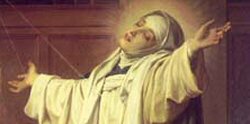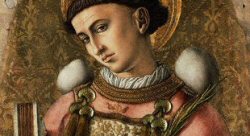 From The National Catholic Register
From The National Catholic RegisterBY Tim Drake, Senior Writer for the Register
The concelebration of a papal Mass is always a sight to behold. There, for the eyes of the world to see, is the Church as it really, truly exists — the Pope, lifting up the body and blood of Christ before the altar is surrounded by the Church’s visible hierarchy of cardinals, bishops and priests in an eternal posture of worship and adoration, leading the laity to Christ.
It is there, at the sacrifice where two worlds meet that we gain a glimpse of heaven that can last a lifetime. Like it or not, the image is one that is ordered, fatherly, hierarchical and fraternal. These words, despite many college professors’ protestations, properly understood, are not “dirty” words.
The priestly posture is one not merely of worship and adoration, but also of protection.
Imagine that someone were to rush the altar, after the consecration, with the intent of profaning the Eucharist. Like the sixth-century acolyte St. Tarsicius, who gave his life to protect the Body of Christ, the priests would instinctively move to protect the Eucharist.
One modern American example of this took place at St. Patrick’s Cathedral on Dec. 10, 1989. Dozens of homosexual activists entered the cathedral with the intention of disrupting Mass. One activist, receiving the body of Christ from a priest, crumbled the consecrated host between his fingers and dropped the broken Eucharist on the floor. A number of priests fell to the floor to pick up the remains.
History is full of examples of the movement of public bodies of men protecting something sacred. The Church is both the protector and the sacred thing to be protected. Christ left a body — the Church — to represent him, and that body is structured in an anticipatory posture awaiting his return.
That posture is summed up in the picture of a body of men, consecrated to Jesus Christ in the corporate fraternity of the priesthood, gathered around the body, made manifest in our presence within the Mass.
We have lost sight of the fact that the Church militant is still engaged in a battle. On the night of his arrest, Christ ordered that Peter sheath his sword drawn against Roman soldiers. Christ then went to the cross, and with the sword of salvation, slew death and descended into hell, mortally wounding Satan. But the battle still rages and will continue to rage until Christ, the servant King, returns.
Yes, Christ served unto death, but he’s also a King, and sometimes kings must lead in battle.
In the Old Testament, it was the priestly tribe, the Levites, who were the leaders and protectors of the Tabernacle. Today, just as most priests forgo marital love for a deeper love, Catholic priests are asked not to take directly political roles because they have a deeper battle to fight.
Eschatologically, the Church is assembled and waiting for that final battle. It’s a fight that doesn’t depend on human strength, but entirely on God. I’ve been blessed to participate in Masses celebrated by retired, disabled and ailing priests in an infirmary chapel. Each time, I am struck by how the priestly posture of worship, adoration and protection is maintained even when age, illness, or infirmity prevent the priests from assuming that posture physically.
Anthropology of the Priesthood
We live in an age where the image of male friendship has been stained to such an extent by the media-saturated example of male-male love that any time we speak of two men’s affection for each other, we think of the disorder rather than the proper order of things.
The anthropology of the priesthood, however, is an anthropology of rightly ordered male communion.
Whenever Catholics gather to remember (“Do this in remembrance of me”) the central event of salvation history, they are gathered by a male in the priestly fraternity — men who have sacrificed both marriage and children to give witness to the truth that eternal life comes from sacramental union with Christ.
They forgo marriage to better carry out their, or rather, Christ’s mission. Even in the Eastern Church, which allows priests to marry, priests may not marry once they’ve been ordained and bishops are not allowed to be married.
“The brotherhood” so often spoken of by St. Paul is the deepest expression of a rightly-ordered way for men to love one another — not in homoerotic selfishness, but in a life-giving reflection of the One who established fraternity.
The Mystery of Paternity
We cannot fully understand the mystery of the priesthood because it is a new reality instituted and centered around Christ himself. It’s difficult to receive this truth when we’ve deliberately set up a culture that questions any authority, especially male authority, and associates all paternity with the patriarchy that had to be overcome — a problem peculiar to the last 50 years.
“Authority ... obedience: To be frank, these are not easy words to speak nowadays,” said Pope Benedict XVI during the Mass at Yankee Stadium on April 20, 2008. “Words like these represent a ‘stumbling stone’ for many of our contemporaries. … Yet, in the light of our faith in Jesus Christ … we come to see the fullest meaning, value, and indeed beauty, of those words.”
The same can be said of the word “patriarchy.” Our discomfort with some forms of cultural patriarchy has made us hesitant to even use the word. Yet, that is a reality connected to this world, not the next.
We’ve lost the capacity to see that ecclesial patriarchy — or priestly “fatherhood” — is a reflection of a natural good. The Church, through its order, is teaching the world a truth that it cannot recognize.
Christ built the Church upon a body of men who entered into a new relationship the evening of the Last Supper. Like the Trinity, the hierarchy is a relationship of persons. The ecclesial hierarchy is made up of the pope, bishops, and priests centered on Christ.
We, as Christians, gain access to the life of the Trinity through the sacraments and the priesthood. By so doing, we are connected to a family of unfathomable size — fellow Catholics worldwide throughout time and space, both living and dead. Through worship, the priesthood makes Christ present in the world.
As both Pope John Paul II and Pope Benedict XVI have said, the male priesthood represents no defect in the personhood of women, or for that matter, of men who are not priests. The dignity of the laity is not diminished because we have not been chosen to carry out the rights and duties and liturgies of the priest. The male fraternity is not oppressive because it is not an end in itself.
“These ranks cannot belong to every individual member of the Church, but that certain ones must be appointed to them by those to whom Our Lord committed such authority,” wrote St. John Fisher in The Defense of the Priesthood in 1525.
Rather, the ecclesial hierarchy excludes many of us in order to save all of us. Liturgy is a work on behalf of the people. In our civic and cultural life this is depicted when our soldiers fight for us, or when we cheer for our sports teams. On a much higher level, priests do this on our behalf through the liturgy.
There is a hierarchy of being — an order — that’s found in nature, in language, in music, in mathematics, in relationships and in natural law.
So, why wouldn’t we expect to find the same within the Church?
“The fact that the Father is not the Son, and the Son is not the Spirit, means that there is an irreversible order within the Godhead,” writes Father James Schall in The Order of All Things. “There is an inner relationship of persons. And one cannot take the place of the other.”
A similar order is found in the Church as established by Christ. In much the same way, neither can a pope, priest or bishop take the place of the other.
Fraternity. Hierarchy. Ecclesial Paternity. We, as Catholics in the new millennium must reclaim and re-propose these words to a confused world. This is how the Church manifests itself universally.
The Church lives out its Catholic character in this way. To deny this is to ignore the truth that martyrs like St. John Fisher laid down their lives to uphold, and dismiss the truth that Jesus Christ handed down to us in a particular way the night before he died.
























No comments:
Post a Comment